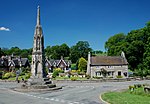Thorpe, Derbyshire

Thorpe is a village and civil parish in the English county of Derbyshire; it is on the Derbyshire/Staffordshire border, on the east bank of the River Dove, about four miles north of Ashbourne. The population of the civil parish as at the 2011 census was 183.Thorpe is at the southern end of the Peak District National Park almost at the foot of Thorpe Cloud, and is used by some visitors as a base for exploring Dovedale and the Manifold Valley. The Limestone Way long-distance bridleway passes through Thorpe, as does the Peak District Boundary Walk.The Dovedale Dash, a 4¾ mile cross-country running race held annually each November, was first organised here in 1953. It formerly had a railway station, Thorpe Cloud railway station, served by the LNWR Ashbourne to Buxton branch line, which linked with the Cromford and High Peak Railway at Parsley Hay. This former trackbed now forms the long distance Tissington Trail cycle and footpath trail.
Excerpt from the Wikipedia article Thorpe, Derbyshire (License: CC BY-SA 3.0, Authors, Images).Thorpe, Derbyshire
Hall Lane, Derbyshire Dales
Geographical coordinates (GPS) Address Nearby Places Show on map
Geographical coordinates (GPS)
| Latitude | Longitude |
|---|---|
| N 53.05 ° | E -1.768 ° |
Address
Hall Lane
Hall Lane
DE6 2AW Derbyshire Dales
England, United Kingdom
Open on Google Maps








